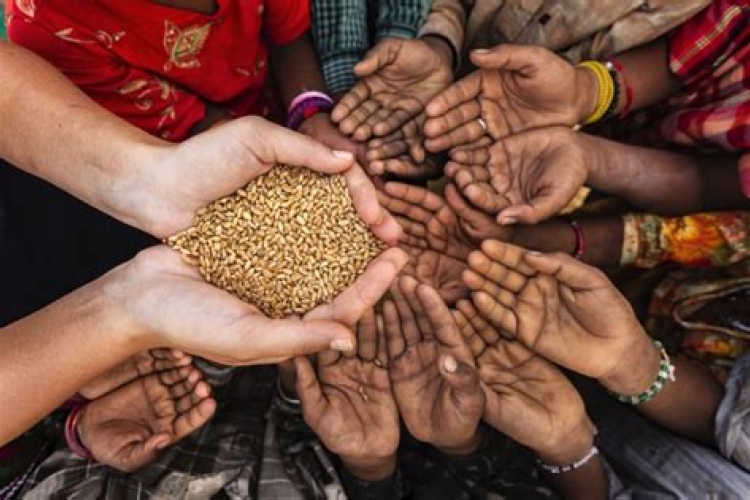Global Hunger on Rise
In News
The number of hungry people in the world is growing again, in large part due to climate change that is wreaking havoc on crop production in much of the developing world - United Nations
Major UN agencies said in an annual report that the number of hungry people facing chronic food deprivation increased to 821 million in 2017 from 804 million in 2016, reversing recent downward trends. South America and Africa showed the worst increase.
Analysis in the report found that climate variability, extreme drought and floods are already undermining production of wheat, rice and maize in tropical and temperate regions, and that the trend is expected to worsen as temperatures increase and become more extreme.
With hunger on the rise for the past three years, the report called for policies to target groups most vulnerable to malnutrition, including infants, children, adolescent girls and women. It called for greater efforts to promote policies that help communities build resilience.
Climate Change and Hunger
Despite having contributed little to cause climate change, the poorest developing countries are already experiencing the effects. Climate change is damaging food and water security in significant ways. This is the greatest environmental challenge the world has ever faced. Feeding everyone on earth would be challenging enough without climate change. The global population is expected to swell to more than 9 billion by the end of the century. With only slight increases expected in available farmland, agricultural production must increase by 70 percent to keep pace with population growth.
How climate change causes hunger?
Production may be less predictable- Without high-tech irrigation systems, most farmers in developing countries depend on rainfall. In regions of the world where rain has declined, crops fail. In places where the arrival or departure of seasonal rainfall has shifted, farmers either plant crops too early or too late, missing the highest rainfall. Even for farmers with access to irrigation or state-of-the art weather information, catastrophic storms and droughts will result in production failures.
Supplies to markets could be less predictable- If production levels fall, the supplies entering markets may also fall. These drops in supply could affect prices for crops — and the livestock that consume crops — and may occur in both developed and developing countries.
Greater risks to those less able to sustain risk-Women are often those at greatest risk as they tend to be the least educated, and own fewer assets and less wealth. High education levels, access to adequate and diverse food throughout the year, adequate early warning systems, and adequate assets, wealth and insurance will often enable people — especially women and vulnerable groups — to cope better with and address the impact of unpredictable weather events. Even if severe storms destroy people’s homes, crops and livelihoods, people with these assets and capabilities can often rebuild their lives quickly after a shock.
Traditional agriculture — a way of life that supports food security — is dying out. In many countries and regions, mobile pastoralists who depend entirely on their livestock herds for their lives and livelihoods are losing their animals to droughts and diseases. Traditional low-input farming is also becoming more difficult due to unpredictable rainfall patterns.
Global Initiatives to tackle hunger due to Climate and Change
FAO, working with governments, civil society, the private sector and other development partners is focusing on fostering political commitment and accountability, improving capacities and mobilizing resources at all levels to eradicate hunger.
- World Food Programme have developed years of experience in collecting, managing and analysing data with the use of advanced technologies such as satellite imagery, Geographic Information Systems (GIS) and mobile data collection platforms in order to identify hungry and food insecure populations and to establish the underlying causes.
- FoodSECuRE - FoodSECuRE is a ground-breaking tool that releases funds based on a forecast before a disaster occurs. FoodSECuRE also ensures funds are available post-disaster, so that resilience-building activities continue over time.
- Obama launched a global food security initiative called Feed the Future G-8 to mobilize at least $3.5 billion toward global food security, which leveraged additional commitments of more than $18.5 billion from other donors.
- Think.Eat.Save is a partnership between the United Nations Environment Programme (UNEP), the Food and Agriculture Organisation of the United Nations (FAO) that seeks to eliminate food waste by promoting action and an global vision on the issue, through an online knowledge portal highlighting initiatives, technical resources and encouraging public commitments.
- CGIAR Research Program on Climate Change, Agriculture and Food Security (CCAFS) aims to promote a food- secure world through the provision of science-based efforts that support sustainable agriculture and enhance livelihoods while adapting to climate change and conserving natural resources and environmental services.
India and Food security
National Food Security Mission a Food Security Mission comprising rice, wheat and pulses to increase the annual production of rice by 10 million tonnes, wheat by 8 million tonnes and pulses by 2 million tonnes by the end of the Eleventh Plan (2011-12).


 IAS -2025 Prelims Combined Mains Batch - III Starts - 14-04-2024
IAS -2025 Prelims Combined Mains Batch - III Starts - 14-04-2024